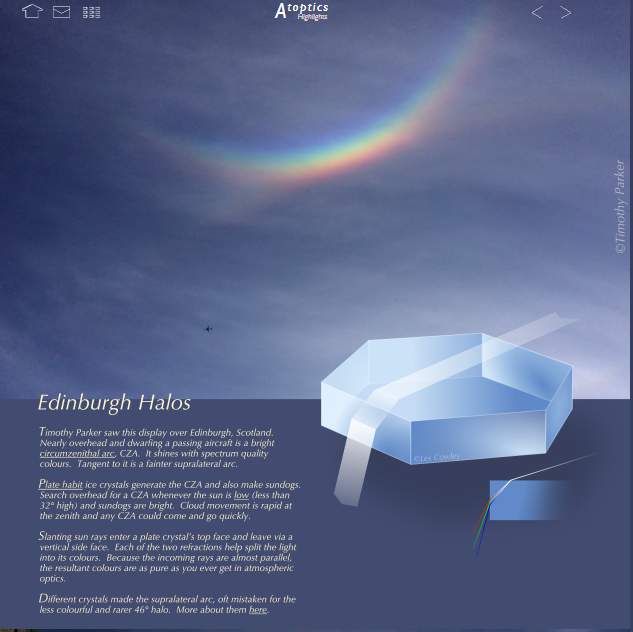Circumzenithal & Supralateral Arcs, Edinburh
Circumzenithal & Supralateral Arcs: A Spectacular Atmospheric Optics Phenomenon in Edinburgh
When it comes to atmospheric optics, few sights can rival the breathtaking display of circumzenithal and supralateral arcs. These stunning optical phenomena were recently observed over the picturesque city of Edinburgh, Scotland, captivating both locals and visitors alike. One lucky observer, Timothy Parker, had the privilege of witnessing this extraordinary spectacle firsthand. The sight was truly awe-inspiring, with a bright and vibrant circumzenithal arc shining almost directly overhead, casting a shadow over a passing aircraft. Tangent to this magnificent arc was a fainter supralateral arc, adding to the magical ambiance of the scene.
The circumzenithal arc (CZA) is created by plate habit ice crystals that are also responsible for the formation of sundogs. To catch a glimpse of a CZA, one must look towards the zenith when the sun is low in the sky, at an elevation of less than 32 degrees. It is worth noting that these arcs can appear and disappear rapidly due to the swift movement of clouds at the zenith. Therefore, timing is crucial when attempting to witness this enchanting phenomenon.
The formation of a circumzenithal arc begins when slanting sun rays enter the top face of a plate crystal and exit through one of its vertical side faces. This refraction process splits the sunlight into its constituent colors, resulting in a dazzling display of spectrum-quality hues. Since the incoming rays are nearly parallel, the colors exhibited by the CZA are exceptionally pure, making it a treat for any enthusiast of atmospheric optics.
While the circumzenithal arc steals the show with its vibrant colors, the supralateral arc is often overlooked due to its fainter appearance. However, this arc is no less fascinating. It is frequently mistaken for the less colorful and rarer 46° halo. The supralateral arc is formed by different types of ice crystals than those responsible for the CZA, adding to the diversity of atmospheric optical phenomena. To learn more about these intriguing crystals and their role in the formation of the supralateral arc, further exploration is recommended.
The observation of circumzenithal and supralateral arcs in Edinburgh serves as a reminder of the wonders that can be found in the sky above us. These phenomena showcase the beauty and complexity of atmospheric optics, captivating both amateur observers and scientific researchers alike. The study of these arcs provides valuable insights into the behavior of light in our atmosphere and the intricate processes that lead to their formation.
As we continue to explore and understand atmospheric optics, it is essential to appreciate the transient nature of these phenomena. Their occurrence is heavily influenced by various atmospheric conditions, including the presence of specific ice crystal types, cloud movements, and the position of the sun in the sky. By studying and documenting these occurrences, we can deepen our knowledge of atmospheric optics and gain a greater appreciation for the natural wonders that surround us.
In conclusion, the sighting of circumzenithal and supralateral arcs over Edinburgh offers a glimpse into the mesmerizing world of atmospheric optics. The brilliance and intricacy of these optical phenomena leave observers in awe, highlighting the beauty and complexity of our natural environment. Whether you are a casual admirer or a dedicated researcher, these arcs serve as a reminder of the wonders that await us when we look towards the heavens. So, next time you find yourself gazing at the sky, keep an eye out for these captivating displays and allow yourself to be immersed in the magic of atmospheric optics.

Edinburgh Halos
Timothy Parker saw this display over Edinburgh, Scotland. Nearly overhead and dwarfing a passing aircraft is a bright circumzenithal arc, CZA. It shines with spectrum quality colours. Tangent to it is a fainter supralateral arc.
Plate habit ice crystals generate the CZA and also make sundogs. Search overhead for a CZA whenever the sun is low (less than 32° high) and sundogs are bright. Cloud movement is rapid at the zenith and any CZA could come and go quickly.
Slanting sun rays enter a plate crystal's top face and leave via a vertical side face. Each of the two refractions help split the light into its colours. Because the incoming rays are almost parallel, the resultant colours are as pure as you ever get in atmospheric optics.
Different crystals made the supralateral arc, oft mistaken for the less colourful and rarer 46° halo. More about them here.
Cles Cowley

Note: this article has been automatically converted from the old site and may not appear as intended. You can find the original article here.
Reference Atmospheric Optics
If you use any of the definitions, information, or data presented on Atmospheric Optics, please copy the link or reference below to properly credit us as the reference source. Thank you!
-
<a href="https://atoptics.co.uk/blog/circumzenithal-supralateral-arcs-edinburh/">Circumzenithal & Supralateral Arcs, Edinburh</a>
-
"Circumzenithal & Supralateral Arcs, Edinburh". Atmospheric Optics. Accessed on November 26, 2024. https://atoptics.co.uk/blog/circumzenithal-supralateral-arcs-edinburh/.
-
"Circumzenithal & Supralateral Arcs, Edinburh". Atmospheric Optics, https://atoptics.co.uk/blog/circumzenithal-supralateral-arcs-edinburh/. Accessed 26 November, 2024
-
Circumzenithal & Supralateral Arcs, Edinburh. Atmospheric Optics. Retrieved from https://atoptics.co.uk/blog/circumzenithal-supralateral-arcs-edinburh/.